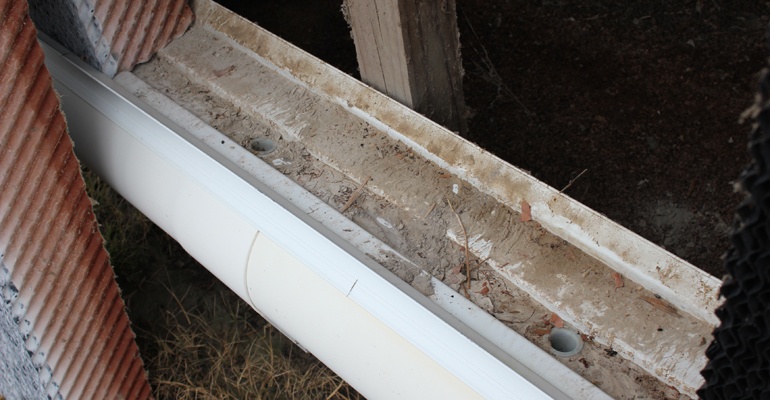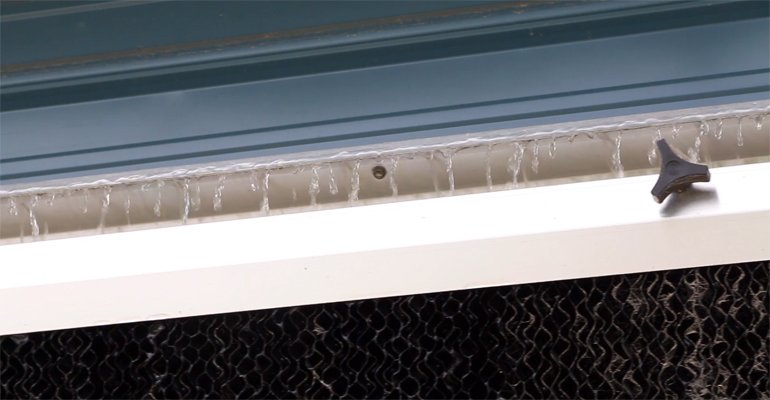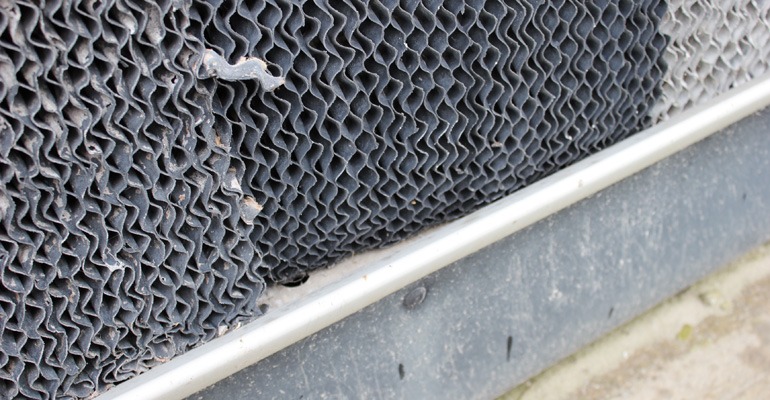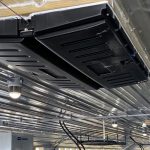Evaporative cooling is an effective tool to reduce heat stress in poultry and livestock buildings. Evaporative pad systems represent a significant investment and require regular maintenance to perform at peak efficiency.
Start up
Over the winter, dust, insect, and dirt may have collected on the pads. Use a hose-end sprayer with a soft bristle brush instead of a high-pressure sprayer to prevent damage when removing debris. Never use bleach-based cleaners that will damage the pads.
Get the sump or jet pumps from inside winter storage and clean out any junk from the strainer basket or pump head before installing them on the supply line. Clean and flush the filter on the supply plumbing.

Inspect troughs for sand and dirt buildup before start up.
Next, remove a few of the pads and remove any sand or dirt buildup in the troughs. Check the joints connecting the troughs and look for gaps and missing caulk. Inspect the trough supports to see if any have come loose from the wall.
Fill the system with clean water ensuring the sump tank or strainer basket (for a jet pump system) is full. Adjust the float to set the water level to about one inch below the pad bottoms. Walk to the opposite end of the system, open the ball valve on the top distribution line, and flush until the water runs clear. Close the ball valve and walk the pad system looking for dry streaks indicating a plugged hole in the spray bar. Dry or streaked pads on the opposite from the pump end mean a blockage in the system is reducing water flow in the distribution line.

Adjust the ball valve on the spray bar to provide even distribution across the pad front.
Distribution lines with many plugged holes or repeated blockages may benefit from mechanically scrubbing the inside of the line using a bottle brush attached to a long PVC pipe. You can also purchase a Clean-out Brush with a slip coupling that glues onto a three-quarter-inch PVC pipe. After running a brush through the spray bar, turn the pump on and flush the system again. With the ventilation system running in full tunnel, adjust the ball valve on the spray bar to provide an even coating of water across the front of the pad without excess water drain from the pads.
Adjustments and Maintenance

Waterlogged bottoms cause pads to soften and sag.
Waterlogged pad bottoms are one of the biggest reasons pads fail prematurely. Continue to check the water level in the bottom trough. The float, correctly set, will hold the water level one inch below the pad bottoms. As pad age, their water holding capacity increases with this extra water raising the trough level.
Instead of “bleeding off” a percentage of the system’s water, dump all the water from the trough and replace it with fresh water to flush all the containments. The water hardness and the amount of evaporation will determine how often to dump the system. Monitoring the PH level is an excellent method to determine when to change the water, with readings above 8.5 indicating an excessive mineral buildup. Monitoring water pH is easily done with inexpensive paper test strips.
Along with flushing the system, adding descalers and algaecides to the recirculation water will help extend pad life. Descalers help keep minerals in suspension, so they can be flushed away while algaecides reduce algae growth. Never use chlorine-based products to kill algae as chlorine attacks the glues in the pads, causing it to delaminate.
Allowing the pads to dry out completely each day greatly extends pad life. This drying period not reduces excessive algae growth but also prevents the pads from becoming soft from constant saturation. Using a stand-alone 24-hour timer or timer in the house controller ensures the pumps shut off each night.
Don’t let poorly performing evaporative systems be the limiting factor in cooling your facility this summer.


